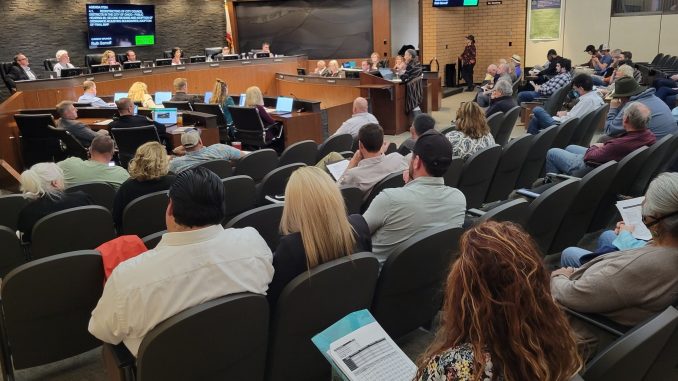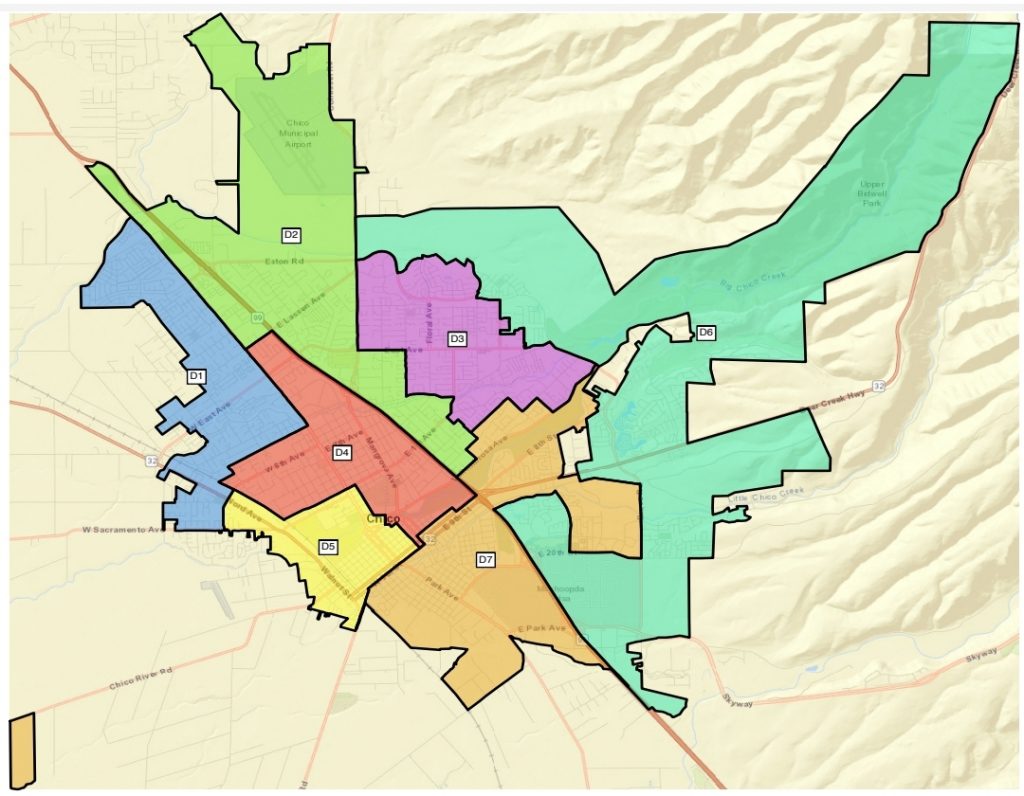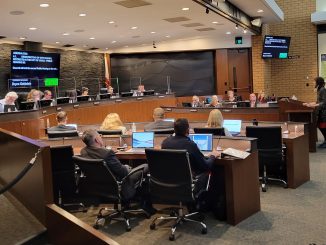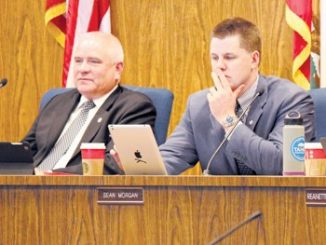
“I’m embarrassed.”
Alex Brown uttered those words Tuesday night (April 5) from the dais of a nearly full Chico City Council Chambers, then again the next morning when reflecting on the action that prompted her reaction.
At the final public hearing on redistricting for the city, where the council needed to selected one map from three finalists in order to meet a state-mandated deadline, five of the six members of the council’s conservative majority approved Map 6C, submitted anonymously and modified by resident Nichole Nava. Only Dale Bennett, a former planning commissioner, joined Brown, the lone progressive, in voting no.
Brown remained in the minority for the rest of the meeting, which extended past four hours of open session alone. She dissented or abstained on two of three appeals for cannabis business licenses; the council upheld staff recommendations to remove these applicants from consideration. Brown also cast the only “no” vote against an ordinance adopting a military equipment use policy for the Chico Police Department.
“Last night was a pretty painful meeting,” she told the CN&R by phone Wednesday (April 6), “because it really illuminated a lot of the lack of transparency in your local government. It affirmed something shady for 10 years in our communities. I’ve said it before and I’ll say it again: Now is a really important time for our community to be looking closely and thinking what the next election cycle looks like.”
The next city election, in November, will be the first under the new district map. It drew support from three of 15 public speakers and 13 of 15 online commenters on the city’s web portal Engaged Chico. The others endorsed Map 2C, by Planning Commissioner Bryce Goldstein, and/or Map 5B, by demographer Claudio Gallegos of ARDA Demographics; these had crossover in design and, consequently, backing.
At the last meeting (March 30), Bennett floated the idea of moving forward strictly with proposals from the demographer—a city-hired professional from Orange County, independent of local politics. Several speakers made the same call Tuesday. Following the previous pattern, Vice Mayor Kasey Reynolds made the motion, which Councilman Sean Morgan seconded, that propelled the adopted map.
“I’ve been digging on this since we’ve started; I’ve been digging on this since we had the [initial districting] process two years ago,” Reynolds told the CN&R afterward. “It wasn’t a clear, easy process then; it isn’t a clear, easy process now. You’re dealing with people, you’re dealing with neighborhoods, you’re dealing with tracts, you’re dealing with so many different things—and you have to make it all come together in the best way possible, in the best way for our community.”
“Everything in Chico is politicization,” she added. “Painting a building yellow [i.e., the Chico Children’s Museum downtown] is politicization…. There is nothing about this that, in me, feels political at all. It’s following the rules, it’s keeping communities of interest together; that particular map only crossed Highway 99 two times, the other [5B] crossed it three times. It kept the majority of everything whole that we wanted to keep whole.
“So, while nothing is going to be 100 percent, I felt like that map best represented the voters of Chico and the communities of interest, which is the most important part.”
Questions to the demographer from Brown, Bennett and Councilman Michael O’Brien drilled down on legal compliance. Gallegos said all three maps met requirements of the California FAIR MAPS Act regarding population variance between districts and voting rights for communities of color—while other elements of the law, such as compactness of districts drawn along natural boundaries, are guidelines open to interpretation. For the latter, he said he would defer to counsel on “legal vulnerability,” but City Attorney Vince Ewing was not consulted.
“This was clearly a foregone conclusion,” Brown said. “I didn’t expect it until I heard one of my colleagues [Morgan] talking about the worst maps that were submitted to us at that first meeting we had an opportunity to talk about them [March 16]; but from that moment, it was clear that there was going to be a shady move to try to make that map make sense, and anyone with eyes can see that it does not make sense.
“I think it was a pretty poorly executed performance piece to move forward maps that were indeed fair, that did indeed honor the FAIR MAPS Act and the guidelines it lays out, just to pick a map that does some very weird and inexplicably illogical things to the districts that we now have to live with for 10 years.”

Brown pointed to a carve-out in District 7, represented by Deepika Tandon, to bring together Meriam Park and the Barber neighborhood; a significant redraw of the previous District 6, which she said would benefit Reynolds should she seek reelection; and how the Avenues neighborhood is split between three districts.
Gallegos told the CN&R that, based on his experience, Chico’s process was fair and included one public meeting more than the law requires. Nava said politics did not factor into her choice of maps to modify nor her revisions; she said that she incorporated feedback from other citizens as well as the city’s Climate Change Vulnerability Assessment. Both Nava and Reynolds cited the report’s consideration of disadvantaged populations as well as Map 6C having the lowest population variance, 3.13 percent.
Brown’s response: “If you look at that map and you think it’s fair, you are fooling yourself…. The biggest red flag in this entire process is we don’t know who submitted that map [originally]—they chose not to identify themselves, they sent it through an alias Gmail account, and that smells a lot like politicking to me.
“We saw with the county process that it had to be uncovered and revealed that a right-wing Republican operative made the maps that were ultimately approved by the Board of Supervisors, and it was the same circular arguments of a square peg in a round hole and what makes a community of interest…. It looks pretty similar, and I’m astounded by the ability of my colleagues to do that with a straight face.”
Cannabis, police policy
Brown again found common ground with Bennett—and Reynolds—during commercial cannabis appeals, but not in debating police policy regarding disclosure and decision-making for military equipment.
The appeals centered on the second phase of a four-step process for licensing three storefront dispensaries that also will be the only outlets allowed to deliver cannabis in Chico. The council, which decided to act as the appeals board, heard first-round appeals Nov. 3. Tuesday, three applicants of 24 total appealed not making the top-10 round.

Council members unanimously denied Chico 580’s appeal but only denied the others by bare margins: 4-3 for Chico’s Best and 4-2-1 (Brown abstaining) for TMG Chico. Those applicants noted ambiguity in the process that impacted their scores enough to fall just shy of making the cut.
“It just seemed like it wasn’t really super clear,” Reynolds explained to the CN&R, “and in fairness maybe let them still continue to go through, because it didn’t seem like there was a huge, egregious thing [against Chico’s Best or TMG Chico], it felt more about process. I felt they could have been good contributing members, possibly, to our community as cannabis owners, and I would have liked to see them move through to the next step.”
Brown spoke about systemic flaws in a process that “disproportionately disenfranchises” small local businesses lacking experience in applying for cannabis licenses that established dispensaries already hold. The city’s consultant, compliance firm HdL Companies, has designed processes for 175 cities and counties. Eight of the 10 applicants advancing in Chico are based out of the area.
“There’s no part of me that thinks integrity is lost on all of my colleagues all of the time,” Brown said, “so I can’t say that I was surprised by Vice Mayor Reynolds and Councilmember Bennett voting in line with the two appeals I voted around. Because I think they can see you’ve got local people who did a really good job and that the process may have hindered them from doing the best job that they could have—and that’s an issue.”
Process sparked Brown’s initial concern with a military equipment use policy for Chico police, which appeared on the consent agenda of the March 16 meeting. She pulled it for separate deliberation. On a 6-1 vote, the council directed then-Captain, now-Interim Chief Billy Aldridge to bring back the proposed ordinance for a first reading. Tuesday’s 6-1 approval, Brown again opposed, brings a second and final vote at the next meeting, April 19.
The ordinance coincides with Assembly Bill 481 regulating the acquisition, funding and use of military equipment by law enforcement in California. Aldridge explained that, for decades, the department has used arms, ammunition and other items defined by the law. AB 481 institutes public reporting of inventory and decisions on purchases by the agency’s local governing body. The legislation took effect in January; the city needs to have a policy codified next month.
Fourteen of 18 public speakers spoke out against the policy—many objecting to this degree of armament.
“Military equipment is never a reasonable use of force,” Margaret Swick said to the council, adding: “Our city is stronger when we do not treat our citizens as enemy combatants.
Those who spoke in favor, joining 11 of 13 who submitted written comments, shared the perspective of O’Brien, the former police chief who made the motion that passed. Referencing the Sacramento mass shooting Sunday (April 3), he said, “I wish it was not the case that we had to respond to these horrific events, but that is our reality. We have to be prepared.”
Reynolds told the CN&R that the community will have another opportunity to weigh in on the policy. “I’m glad we had a good robust conversation on it,” she continued, “and I’m all about taking care of the safety of the community members.”
The following day, Brown still questioned transparency—“the common thread” of the meeting’s big items.
“It’s not transparent to align with a bill that’s meant to invite the public in and inform them of police practices by tucking it away in [a] consent agenda and tucking away budget numbers in the report without saying there’s any fiscal impact,” she said. “I know we don’t like state mandates; it is what it is. Sometimes the state passes bills that make us [in city government] have to do additional work and be more transparent. But they exist for a reason.
“I think it’s best to honor the spirit of that and be transparent.”




Be the first to comment